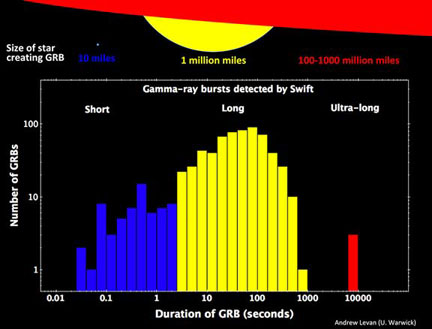“With this ring (a remnant of a dead neutron star), I thee wed.”
Gamma rays
are the highest energy form of light, and gamma ray bursts (GRBs) are
our universe’s most spectacular explosions. We believe they are related
to collapsed stars, either neutron stars or black holes. We used to
think there were only two types: (1) Long GRBs lasting 20 to 50 seconds,
possibly originating in the collapse of massive stars, forming black
holes; and (2) Short GRBs, often coming and going in 1/5th of a second,
with the usual suspects being merging neutron stars or black holes.
NASA’s
Fermi and Swift space telescopes are detecting about one GRB per day.
Below is a full-sky image taken at gamma ray frequencies. For a brief
period, one GRB outshines the entire universe.

Now it
seems that a third type of GRB exists. And these cosmic catastrophes may
be the origin of almost all the gold and other heavy metals in the
universe.
My
newsletter of Dec. 2011 reported on the spectacular “Christmas GRB” that
occurred on Dec. 25, 2010 and lasted 28 minutes. Then, no one knew
whether it was naughty or nice. “Nice” meant a modest explosion from an
asteroid or comet falling onto a neutron star within our galaxy.
“Naughty” meant a very remote but catastrophic collapse of a neutron
star and a normal star, forming a black hole. Now we know it was even
naughtier, even more remote, and lasted even longer than originally
imagined. New observations identified the Christmas GRB’s host galaxy
and determined it was 7 billion light-years away, probably powered by
the collapse of a star hundreds of times more massive than our Sun.
Other data show low-level emissions continued for 2 hours. This GRB was
the first of a new and more spectacular class of cosmic explosions: ultra-long GRBs.
All cosmic
explosions are powered by gravity. Intense beams of high-energy
particles are created in the cores of collapsing, extremely massive
bodies. These beams emerge as highly collimated jets, blasting outward
and creating gamma rays as they pass through the bodies’ outer layers.
The thickness of matter that the jets blast through determines the
duration of the GRB. For a compact object, such as a single neutron
star, jets reach its surface in less than a second, and the GRB is
short. For an hours-long GRB, the collapsing body must be as much as
1000 times larger than our Sun. Blue supergiant stars fit the bill,
particularly if they were first generation stars devoid of heavy
elements.
NASA provided this comparison of cosmic explosions, with duration plotted horizontally and energy release plotted vertically.

The green
zone contains long GRBs, powered by massive but compact stars collapsing
to form black holes. The purple zone corresponds to entire stars and
solar systems falling into supermassive black holes. The orange zone
contains supernovae and also the annihilation of smaller bodies falling
onto neutron stars or modest-sized black holes. The blue zone contains
the ultra-long GRBs, powered by extremely large and massive stars
collapsing to form black holes.
The ultra-long GRBs are quite rare, as shown in the plot below of the durations of observed GRB’s.

So where’s the gold?
Scientists
at the Harvard-Smithsonian Center for Astrophysics now believe that the
collision of two neutron stars produces considerable amounts of gold and
other heavy elements, in addition to a short GRB. They attribute the
slowly fading infrared light seen after short GRBs to radioactive decay
of very heavy elements, some of which will become gold.
“We
estimate that the amount of gold produced and ejected during the merger
of the two neutron stars may be as large as 10 moon masses – quite a lot
of bling!” said lead author Edo Berger. That’s a billion, trillion tons
of gold among the 20 trillion, trillion tons of collision debris.
They
multiplied their estimate of gold production in a single collision by
the number of GRBs estimated to have occurred over the age of the
universe. The result, they say, could account for all the gold that we
observe in the universe today.
The gold in your ring (or your teeth) may have come from colliding neutron stars and the subsequent gamma ray burst.
Best Regards,
Robert
July 23, 2013
Note: Previous newsletters can be found on my website.
|